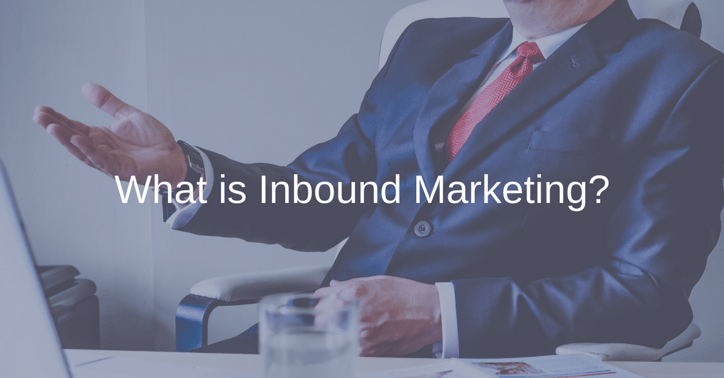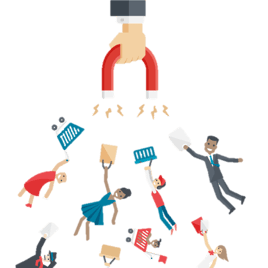There’s been a lot of buzz around inbound marketing the last couple years, and that’s because it works. As marketers, we need to stay agile and adapt to the preferences and demands of customers in order to effectively acquire and retain a loyal customer base. Whether you’re new to the concept of inbound, or are looking for a quick refresher, this post will highlight the essence of inbound marketing.

What is Inbound Marketing
Put simply, inbound marketing is the process of attracting strangers to your site, converting them into leads, and nurturing these leads to the point of purchase, thus converting them into loyal, returning customers.
This is a very simplistic definition, and as with any marketing activity there are intricate details that go into building a strong strategy. Inbound puts the focus on the user, and their experience during their journey towards a purchasing decision.
Embrace Contextual Marketing
As the name implies, contextual marketing is marketing that has context. So what does this means? It means you’re paying attention to what your target audiences engage with, and sending them relevant information that will help move them through the marketing and sales funnels.
Publishing the right content in the right place at the right time will make your marketing relevant to your target audience. Developing in-depth “buyer personas” will allow you to understand the type of content to create for your target audience. Inbound requires extensive targeting as it focuses on exactly who is looking for the value you offer.
Major Themes of Inbound
There are a lot of different aspects to a working strategy, but there are a few themes that permeate through the entire inbound process.
Content Creation and Distribution

Although they’re similar, inbound marketing and content marketing are very different. Your inbound campaigns cannot perform the way they’re supposed to without the creation and smart distribution of content to your audience. It’s essential that you regularly create content for users to consume in order to encourage them to the point of purchase.
Lifecycle Marketing
Lifecycle marketing is focusing on where users are on their buying journey, and delivering specific content based on how far off they are from a purchase. As an inbound marketing agency, we keep track of everyone in your database, as well as how they interact with your site.
Personalization
This track record of contact information allows us to send personalized messages based on what they’re engaging with. Many marketers think that personalization can only go as far as including a contact’s name in an email, but inbound takes personalization to the next level. Personalized marketing is relevant marketing. It has context and you’ll be able to connect with your audience in a much more effective way.
Multi-Channel Integration
Once you have the content created, it’s time to go ahead and share it on all the channels your audience spends their time. Whether it’s YouTube, social media, their inbox, or various blogs, you need to be there.
As you can probably see, the efforts that go into creating an effective inbound marketing strategy are compounding. In other words, the longer you create personalized and relevant content across all marketing channels, the more exposure your content will have. This mean more traffic to your site, and ultimately increased revenue for your business.
What Inbound Isn’t
To really understand what inbound marketing is, you need to completely understand what it isn’t. Many companies trying to implement an inbound strategy fail to grasp what it isn’t, setting their campaigns up for failure. Keep these in mind when you’re planning out your strategy so you can make sure you don’t revert to ineffective push marketing tactics.
Inbound isn’t a quick fix solution
With the rise of the digital landscape, we’ve become accustomed to quick-win solutions for many of our problems. However, if you’re looking for marketing solutions that provide quick results, you might be better off dumping your budget into an elaborate pay per click campaign.
Inbound requires hard work, and depending on the current standing of your website it could take a few months to a year to see the results you hear about in the success stories. If you’re hiring an inbound marketing agency, remember that it takes time for the process to get set up and working the way it’s intended.
Inbound isn’t traditional
Traditional marketing depends on push tactics. This means they take a generalized message and push it in front of their mass, target audience hoping it rings a bell. Inbound recognizes the inefficiency in this approach and uses a pull approach instead.
A pull approach focuses on targeting the right users instead of hoping someone in the mass population finds your message relevant. In other words, inbound embraces the essence of contextual marketing and provides the right information to the right person at the right time.
Inbound isn’t easy
When you start to see results from inbound, it might seem like everything is coming to the business easily. When done correctly this is the result you want, but the process leading up to it takes hard work, dedication, and hours of research. Since inbound delivers an omni-channel marketing experience, it takes time and effort to set up consistent messages across all channels to ensure your users are getting the promised value, wherever they might be.
Is Inbound Right for Your Business?
We get this question a lot, and as an inbound marketing agency and we have a simple answer: It depends. Inbound marketing isn’t right for every business out there. If your current business and marketing model is working great for you, don’t fix it if it’s not broken. However, if you’re looking for a long term digital marketing solution that will help you achieve business goals you consistently fall short on, inbound might be a good option.
Not all industries are created equal
There are a few industries that we see inbound perform exceptionally well for. Typically, the longer the purchasing decision takes, the better inbound will be.
For instance, inbound works great for the automotive industry, as the typical car buying process consists of over 14 hours of online research. This means there is more time for car shoppers to search around for the valuable content a dealership creates, thus adding value to the model that is right for them.
Another industry that is great for inbound marketing is the hospitality industry. Think about it, no one wants to book a sub-par vacation. Unless they’re dedicated to going to the same place and staying at the same hotel each time, travelers do quite a bit of research when deciding on where to vacation, and what to do once they get there.
Are you focused on short or long term goals?
As mentioned earlier, inbound marketing is not a quick fix solution. It takes time to create a library of content across multiple channels for your audience to engage with. Not only this, but you need to research and analyze your inbound strategy on an ongoing basis. It doesn’t happen overnight and there’s no such thing as perfect.
With that being said, inbound is great for companies who are focused on developing a long-term marketing strategy focused on sustained business growth.
Closing Thoughts
As the marketing industry shifts it’s focus towards digital, inbound takes it a step further by putting the focus on the customer. Doing so allows companies to create marketing that people love in return for brand loyalty. When you deliver a great customer experience, there is no reason why customers won’t spread the love and tell their friends. They’ll be compelled to share the great experience they had with your company, and will establish your company as a company people love to do business with.





.jpg)